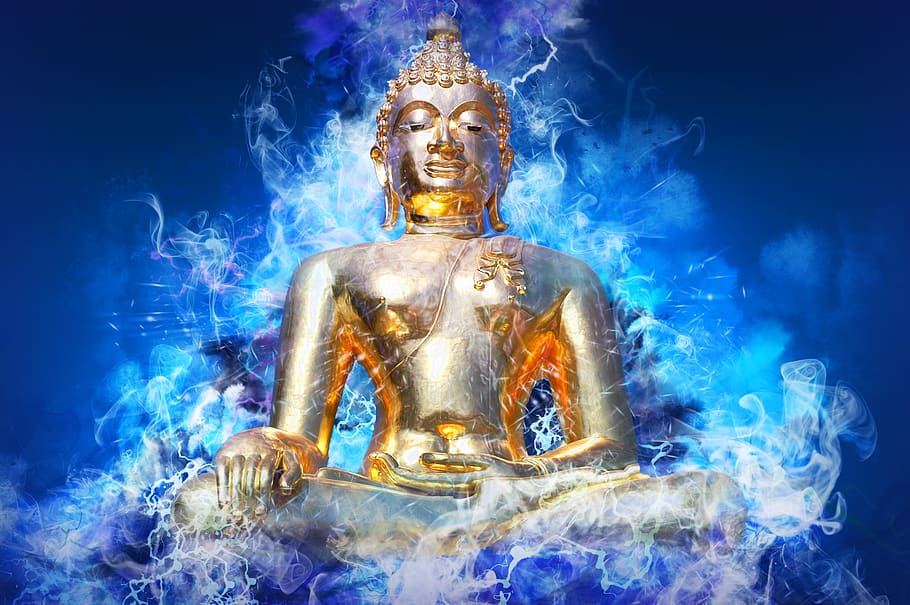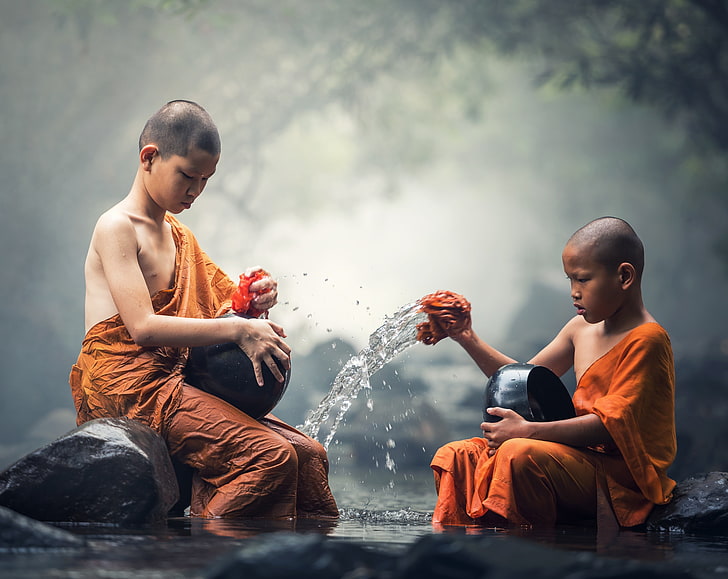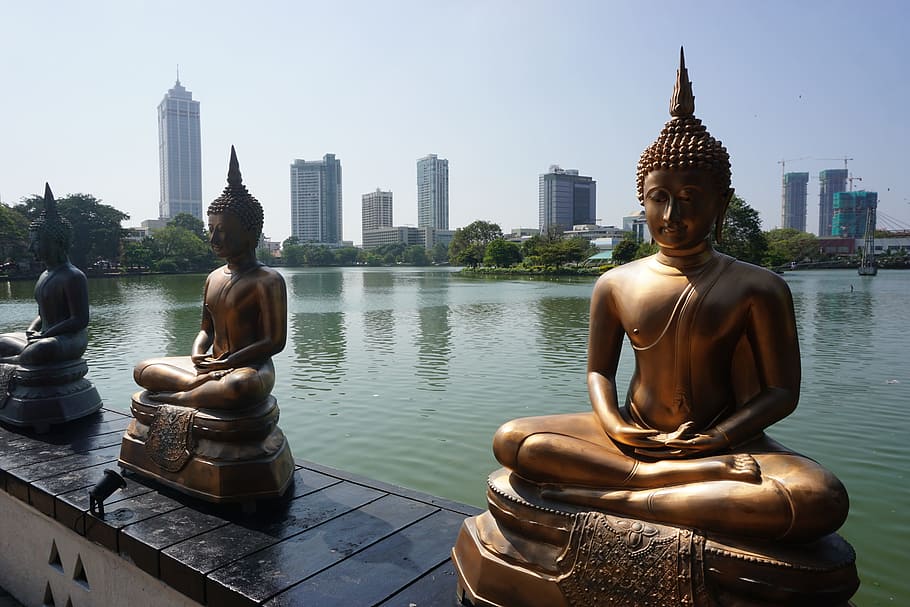How to become a Buddhist Nun and Buddhist monk

Buddhist Nun and Buddhist monk

Buddhism is frequently referred to as a belief system or a way of life. Buddhists, unlike adherents of other religions, are not required to follow prescribed rituals, though some Buddhist practises do include elaborate rituals. Meditation is the fundamental practise of Buddhism, and it is intended to bring awareness to our mind and our true enlightened nature. Meditation, according to Buddhists, is necessary to calm the endless thoughts and distractions that otherwise fill our minds. While Zen Buddhism emphasises self-discovery, Tibetan Buddhism emphasises a path of compassion for all living beings.
Becoming a Buddhist monk or nun is an incredibly meaningful and worthwhile way to spend your life and help others. We are extremely fortunate that the monastic tradition established by the Buddha is still alive and well today, thanks to the devotion, dedication, and efforts of many thousands of monks and nuns in Asia over the last 2500 years. Although there are many advantages to becoming ordained, the life of a Buddhist monk or nun entails a great deal of responsibility for oneself and others.
READ ALSO: Non Cdl Jobs Near Me
Understanding Buddhist Teachings
Before deciding to take ordination, one should have a solid understanding of the Buddha’s teachings, such as the Four Noble Truths, the Eightfold Path, and the Stages of the Path to Enlightenment (lam-rim). A student requesting ordination has traditionally completed several years of study and practise under the supervision of a qualified teacher. If you are just starting out, look for a centre or study group in your area where you can gain an understanding of the teachings, gain the support of other dharma students, and be guided by a qualified teacher.
Having a Spiritual Advisor
We need someone to teach and guide us in any endeavour we embark on. This is especially true in our spiritual journey, where a qualified teacher can provide the guidance we require for success. Our teacher can help lay the groundwork for the monastic life and will recognise when we are ready to commit to the monastic vows of ordination. You must have a teacher who will grant you permission to be ordained.
Starting on the Buddhist Path
Take your time developing your spiritual practise. Once you recognise the value of the Buddha’s teachings and believe they are applicable to your own spiritual development, the next step is to formally establish yourself as a Buddhist by taking “refuge.”
It is also important to strengthen one’s practise by taking “lay vows,” which prepare one for living with vows; many students will also practise celibacy prior to ordination. Know yourself and whether you will feel at ease as a monk or nun.
Regarding Ordination
Spend some time, if possible, living in a monastic community and getting advice from the resident monks or nuns on what it’s like to be a monastic. Consult with monks and nuns who have lived with the vows and can provide very practical advice on how to stay committed. Members of the monastic community are delighted that you are interested in the monastic path and wish to assist you with your ordination. Online resources and articles are also available.
Programs are being developed in which lay practitioners considering ordination can learn about and experience the monastic life in a safe retreat setting.

A Commitment for Life
A Buddhist monk or nun’s vows are taken for life, so it is critical to spend time and care in considering the various advantages and disadvantages before making a decision. Some Asian monasteries (for example, in Thailand) offer part-time ordination programmes for men, allowing them to live as a monastic for a few days, weeks, months, or years. In the Tibetan tradition, however, one makes a lifelong commitment. And, while there have been cases of people taking vows and then returning to lay life, this is not recommended. The vows are made with the intent of keeping them for the rest of one’s life.
Being a Member of a Group
Becoming a Buddhist monastic entails joining a community known as the Sangha. The community’s mission is to study and practise the Buddha’s teachings, and to share them with others whenever possible. Traditionally, after becoming ordained, one must live in a monastic community for at least 5 years. This is not always possible, however, because monastic communities are still developing in many parts of the world. In some cases, one can also live within a dharma centre while being guided and protected by one’s teachers. Prior to ordination, one should investigate the options for joining monastic communities.
Living in community also entails sharing our resources, habits, practises, and personalities. Learning to live in a community can be difficult, especially because many of us were raised in individualistic cultures. The vinaya (code of conduct) for monastic life is very explicit in how we live in community in order to protect our ordination.
Taking Care of Yourself
When one enters a monastic community, the four basic necessities of food, clothing, shelter, and medicine are traditionally provided. However, because Buddhism is still in its early stages in many parts of the world, resources to support monastic communities are limited.
Rites of Passage for Buddhists
Buddhism, like most other religions, has specific rites of passage for its devotees, from tribal societies to developed nations. Despite minor variations depending on the Buddhist sect, these rites are a way for people to commit to the path of the Buddha’s teachings. Buddhist rites of passage occur in stages throughout one’s life and spiritual development journey.
Rites of Passage in the Time of the Buddha
When the Buddha first started teaching the principles of enlightenment and the path to this revered state, he admitted anyone into his monastic order. The only requirement was to take a five-precept vow: do not kill, steal, be unchaste, consume intoxicants, or lie. Though he initially only established a monastic order for male monks (bhikkus), he later allowed women to join the order (bhikkunis). Because the requirements for becoming a Buddha disciple were so minimal, it is estimated that the number of monks and nuns reached over 1,000 people in less than seven months after the Buddha began teaching.After thoroughly teaching his disciples the dharma and the path to enlightenment, he sent them out into the world on a never-ending journey to teach others about the path.
The First Step to Becoming a Buddhist

How to Become a Buddhist
The first step in truly committing to the Buddha’s teachings is to take refuge. There are three main sources of peace and sanctity in Buddhist beliefs, known as the Triple Gem: the Buddha himself, the dharma (his teachings), and the sangha (the worldwide group of Buddhists). Taking refuge implies a commitment to all three and a desire for enlightenment. This fundamental step is shared by both Theravada and Mahayana Buddhism; however, Theravada emphasises individual enlightenment, whereas Mahayana emphasises enlightenment for the benefit of all beings.
Men’s Monastic Rites of Passage
There are two levels of ordination for men, lower and higher, which are determined by age and experience. One must be in good health and free of any communicable diseases, as determined by a series of specific questions. The requirement for lower ordination is simply the renunciation of secular life. Giving up most material possessions, shaving the head, learning the fundamentals of the Buddha’s teachings, and accepting the monastic lifestyle are all part of this. Because the goal of becoming a bhikkhu is to attain perfect knowledge, or enlightenment, monks are only permitted to own eight items: three robes, a begging bowl, a water filter, a belt, and a sewing needle.
Higher ordination must be approved by at least two monks and unanimously agreed upon by all members of the monastery’s sangha. In general, male ordination entails taking vows for 277 precepts, complete renunciation of a householder’s life, and total devotion to the Buddhist path according to Vinaya, or monastic, law.
Women’s Monastic Rites of Passage
Though there was no separation in Buddhist practise at first, different styles and forms of Buddhism have emerged since the Buddha’s time and continue to thrive. Women were always permitted to join the Mahayana monastic order. For nearly 800 years, women were not permitted to be ordained in the Theraveda tradition; however, this changed in the late twentieth century.For nearly 800 years, women were not permitted to be ordained; however, this changed in the late twentieth century. Women are ordained in three stages: renunciation of secular life, training and preparation for ordination, and full ordination. Buddhist nuns are distinguished by their level of learning (novice or experienced), who ordained them, and when they were ordained. Nuns must take 34 vows in addition to the 277 originally required of men, for a total of 311 precepts for full female ordination.
What are the vows taken by Buddhist nuns?
Women have been an integral part of the Buddhist tradition since the time of Siddhartha Gautama, also known as the historical Buddha. The Buddha was asked to allow women into his followers’ monastic group while he was still alive. Though he initially declined this request due to the societal views of women in India at the time, he eventually changed his mind and founded a monastic Order for Women that has had observants all over India for nearly 1200 years. Women have been barred from taking full monastic vows and becoming nuns in the Theravada tradition for the last 800 years.
READ ALSO: Steps on How to Lose Belle fats overnight with Vaseline
This changed in 1987, and in 1996, women were officially granted the right to be equal to their male counterparts in the levels of commitment they could achieve within the Buddhist tradition. Convents have formed in Eastern countries where Buddhism is a major religion since this time, and the path to becoming a nun has been re-institutionalized and solidified.
How Women Became Nuns During the Buddha’s Time
While the Buddha was still alive, his ordination requirements were limited. Anyone who wanted to hear his teachings and follow the path to enlightenment only had to give up their secular lives and make vows in the eight precepts. Killing, stealing, lying, sexual misconduct, consuming intoxicants, eating between noon and dawn, pleasure acts such as singing, dancing, and listening to music, and any personal ornamentation, such as perfume, that bears a connection to seduction were all prohibited. Though the Buddha originally created this order for men only, at the request of his foster mother Maha Pajapati-Gotami, he reconsidered and allowed women to become ordained members of his followers as well.
All Buddhists Must Make These Promises
The five precepts are the most fundamental vows that any Buddhist practitioner, regardless of gender, must take. A person chooses to devote themselves to the Buddhist path by taking vows in the five precepts and undergoing a formal ceremony that dedicates their life practises to the Buddha, the dharma (the Buddha’s teachings), and the sangha at a ceremony known as taking refuge (the worldwide community of Buddhists). These are the first five of the eight precepts required for ordination during the Buddha’s time, but they can be expanded to the full ten precepts taken as a first step towards ordination, which include the additional vows of not determining oneself to be in a higher position than others and accepting any monetary gifts
Becoming a Buddhist Nun Requirements
While the requirements for becoming a nun or a monk were the same during the Buddha’s time, there were already differences in expectations. The Buddha, for example, required monks to meditate alone in the forest, but he deemed this practise unsafe for women’s safety. Aside from differences after ordination during the Buddha’s time, current differences between men and women on the path to ordination resulted from the Buddha’s Vinaya law teaching that women “need to be ordained gradually.” As a result, in order to enter monastic life, a woman must take specific steps and vows. The first is the abandonment of secular life.

At this preliminary stage of ordination, a woman must demonstrate her physical and mental health and give up all of her material possessions. At this stage, the primary vows are the full ten precepts.
Women’s Vows to Enter the Monastic Life
After giving up secular life, women must complete two additional steps before being ordained. She progresses from novice ordination to probationary ordination and finally to full ordination. Many vows can be taken during the probationary period, including the Bodhisattva vows, which were taken by a well-known Buddhist nun named Thubten Chodron.
These vows serve to remind monastics of the 62 obstacles to practising true compassion and remaining on the Buddhist path, and they are intended to express that the practitioner is seeking enlightenment not only for herself, but also for the benefit of all living beings. For full ordination, women must take vows in 311 precepts addressing everything from moral discipline to generosity, which is 24 more vows than male ordained monks.
The Levels of Buddhist Monks
Those who devote their lives to the monastic tradition play an important role in Buddhism. They are referred to as monks or the Sangha collectively. They officiate at marriages and provide religious guidance to lay people, who are religious practitioners who have not been ordained. Because Buddhism is so diverse, not all monastic orders follow the same hierarchical structure. A Theravada monastery in Sri Lanka will be very different from a Zen Buddhist temple in Ohio. Within Buddhist monastic life, there is some general order: lay people live outside the monastery walls, while monks live inside.
1.
Laity
Lay people, also known as laity, are Buddhists who have not been ordained. Laity adhere to the five precepts, which provide guidance for body and speech discipline. Because Buddhist monks take poverty vows and devote their lives to religious study, they rely on the laity for necessities such as food, clothing, and medicine. Monks, in exchange, provide religious services at weddings, birthdays, and funerals. Laity also gain merit for their charitable actions.
2.
Monks
Buddhism has many different branches all over the world. Each branch operates independently and has its own monastic structure. The Roshi is the spiritual head of Japanese Zen temples, while another head monk is in charge of the temple’s business. The monastic order in Thai Buddhism is divided into 62 ranks. Buddhist monks are divided into two categories: novice monks (or samanera) and bhikkhus.
Buddhist Nun and Buddhist monk
3.
Samanera
A novice monk, also known as a samanera, is one who has been accepted into the monastery but has not yet received higher ordination. Samanera makes a vow to follow the ten precepts, receives a new name, and has their head shaved by other monastery members. While samanera adhere to many of the same rules as full-fledged monks, they are still ranked lower until they complete the higher ordination procedure and become a bhikkhu.
4.
Bhikkhu
Within the Buddhist tradition, a bhikkhu is a fully ordained monk. A bhikkhu must follow the Vinaya teachings in addition to the ten precepts. A bhikkhu must follow many strict rules regarding his or her interactions with the laity, such as not accepting anything that is not offered and refraining from lewd behaviour or speech with women. A bhikkhu is responsible for many ceremonies for lay people as well as important work within the monastery.
How Does a Buddhist Demonstrate Absolute Commitment to Their Beliefs?

1.
Meditation
Buddhism’s central practise is meditation. Buddhists demonstrate their devotion to their beliefs by meditating on a regular basis. There are no specific times of day, number of sessions per day, or length of time requirements, though many Buddhists establish a meditation routine to ensure they practise every day. The fundamental commitment is to set aside regular time to rest in awareness of the true nature of one’s mind.
2.
Compassion
The Four Noble Truths are the central Buddhist teachings: the truth of suffering, the truth of the cause of suffering, the truth of the end of suffering, and the way or path to the end of suffering. Buddhists cultivate compassion and a desire for all living beings to be free of suffering and its causes. A Buddhist may perform tangible acts of charity or generosity to demonstrate complete commitment to this belief, but the primary practise is generating compassion through meditation and the way one lives all the time.
3.
Taking Solace
The ceremony of taking refuge marks one’s commitment to being a Buddhist. The ceremony is led by a qualified teacher; the practitioner vows to follow certain precepts and is given a Buddhist name. The five fundamental precepts are not to kill, steal, lie, become intoxicated, or engage in sexual misconduct. Taking refuge may demonstrate one’s commitment to being a Buddhist; however, a Buddhist demonstrates commitment to his or her beliefs through how he or she lives on a daily basis.
4.
Retreat
Going on a Buddhist retreat may deepen a Buddhist’s commitment to his or her beliefs, or it may be something a Buddhist believes is required to further his or her learning and understanding. A retreat can last as little as one day or as long as many years, and it can focus on specific teachings or practises. Engaging in a retreat may indicate a Buddhist’s commitment to his or her beliefs, as a retreat requires one to disconnect from daily routines such as jobs and communication with the outside world; however, the intent is to focus on practise rather than an outward display of commitment.
What Do Buddhist Monks Believe?
Buddhist monks believe that Buddha attained enlightenment and then disseminated his successful methods in order for all living beings to eventually exist in perfect understanding and bliss. They take vows to devote their lives to Buddha’s teachings, choosing between the Theravada tradition of seeking refuge in order to personally achieve Nirvana and the Mahayana tradition of pledging to be reborn indefinitely in order to help all beings achieve enlightenment. With one critical difference, the two monastic schools share fundamental beliefs.
1.
The Three Jewels
Buddhist monks hold three fundamental beliefs that guide them on their journey to enlightenment. These are known as the Three Jewels, and they all begin with faith in the Buddha – not as a god, but as an enlightened being and great teacher. The second jewel is faith in the dharma, the Buddha’s teachings on how to live – what to strive for and what to avoid – in order to “wake up” from the illusions that obscure the truth of existence. Ahimsa, or the principle of nonviolence, is a Buddhist dharma. The monastic discipline of eating one main meal at midday to encourage self-control and generosity is also practised. The third jewel is the sangha, a Buddhist community that promotes lifelong learning.For monks, the sangha is their monastic order or abbey.
2
There are three paramitas.
The three paramitas are the universal truths or understandings that represent enlightenment. Monks meditate, study the sutras, and contemplate these three truths in order to fully comprehend them and direct their actions accordingly. Everything changes; this impermanence causes human suffering; the self is not a separate being and is subject to change are the fundamental paramitas. Monks believe that their karma from previous lifetimes has allowed them to be reborn into a monastic life, and depending on their tradition, they may take bodhisattva vows to postpone their own entry into nirvana. A bodhisattva vows to reincarnate indefinitely in order to assist all beings in attaining enlightenment and the eternal bliss of awakening from illusion. This awakening includes acknowledging the three universal paramitas
3.
Four Noble Truths
The Buddha first revealed the Four Noble Truths to a group of five monks, indicating the pragmatic nature of Buddhism. They deal with his initial realisation of the existence of suffering, which led him to abandon his royal life and seek enlightenment through direct experience of the world, asceticism, and meditation. The Four Noble Truths are dukkha (suffering exists), samudhaya (desire and attachment cause suffering), nirodha (desire can be extinguished by releasing attachment), and magga (the method of following the Eightfold Path to end suffering). This is Buddha’s Middle Way, neither too austere nor too indulgent, and it serves as the foundation for the monastic rules for daily life that govern monastic communities.